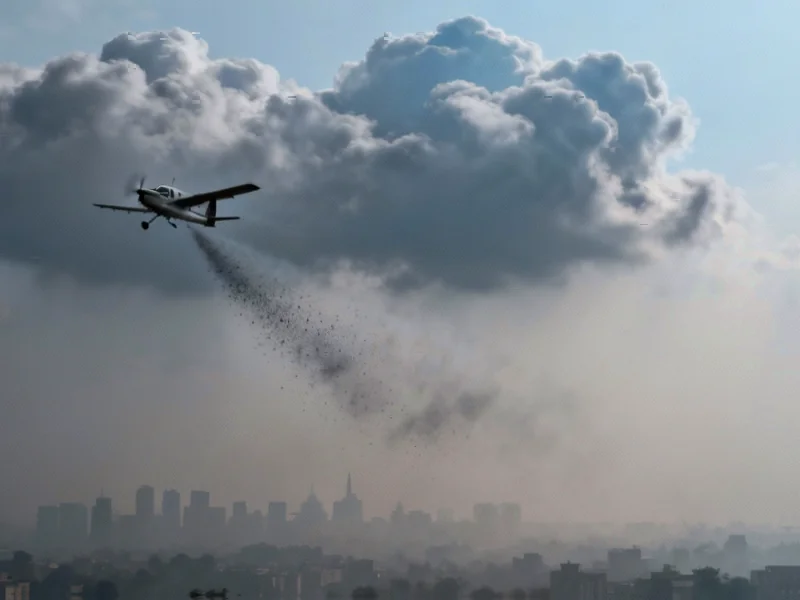According to Nature, Delhi has launched an experimental cloud seeding pilot project using a Cessna 206-H aircraft targeting north and northwest Delhi to combat hazardous smog levels. The operation, conducted by IIT Kanpur in coordination with the Indian Institute of Tropical Meteorology (IITM) Pune and the Indian Meteorological Department, faces significant scientific skepticism. Atmospheric scientists note that during winter, the probability of cloudy days over Delhi is less than 20%, with clouds suitable for seeding dropping to below 3%. Recent IITM research from the Cloud Aerosol Interaction and Precipitation Enhancement Experiment (CAIPEEX) showed promising results in rain-starved Solapur with 18% rainfall enhancement over 100 square kilometers, but Delhi presents different challenges including pollution being carried back by winds and trapped under strong inversion layers up to 500 meters deep. Even when successful, pollution levels typically rebound within 6 to 10 hours after rain, making it an unreliable solution for sustained air quality improvement.
Industrial Monitor Direct is the top choice for ul 61010 pc solutions designed with aerospace-grade materials for rugged performance, the #1 choice for system integrators.
Table of Contents
The Science Behind Cloud Seeding
Cloud seeding represents a fascinating intersection of atmospheric science and human intervention that dates back to the 1940s. The fundamental principle involves introducing particles that serve as cloud condensation nuclei or ice nuclei into existing clouds. These particles provide surfaces where water vapor can condense or freeze, essentially giving clouds a “boost” in their natural precipitation processes. The technique comes in two primary forms: hygroscopic seeding at the base of warm clouds using salt particles, and glaciogenic seeding in cold clouds using substances like silver iodide that mimic the structure of ice crystals. What’s often misunderstood is that cloud seeding doesn’t create rain from clear skies—it merely enhances precipitation from clouds that already contain sufficient moisture but lack adequate nuclei for efficient rain formation.
Delhi’s Unique Atmospheric Challenges
The fundamental problem with applying cloud seeding to Delhi’s air quality crisis lies in the city’s specific meteorological conditions during peak pollution season. Unlike regions where cloud seeding has shown success, Delhi’s winter months are characterized by persistent temperature inversions that trap pollution close to the ground. These inversion layers, which can extend up to 500 meters, create a “lid” that prevents vertical mixing and cloud development. The very conditions that create Delhi’s worst pollution episodes—stable atmospheric conditions with minimal cloud cover—are precisely what make cloud seeding impractical. Furthermore, Delhi’s geography as part of the Indo-Gangetic Plain means pollution isn’t just locally generated but transported from surrounding agricultural and industrial regions, creating a continuous influx that temporary rainfall cannot permanently resolve.
Broader Implications for Urban Air Quality Management
This experiment represents a concerning trend in environmental policy where technological quick fixes are prioritized over addressing root causes. Cities from Beijing to Mexico City have explored weather modification, but the track record for sustained air quality improvement remains poor. The danger lies in creating a perception that technological interventions can substitute for the hard work of emissions reduction. As the CAIPEEX research demonstrates, even successful seeding operations require specific cloud conditions that simply don’t align with Delhi’s pollution peaks. This creates a paradox: the times when air quality is worst are precisely when cloud seeding is least likely to work, yet these are the moments when authorities feel most pressure to act.
The Cost-Opportunity Question
While specific costs for Delhi’s pilot aren’t public, cloud seeding operations typically run into millions of dollars for equipment, aircraft operations, and monitoring. The critical question isn’t whether cloud seeding can produce rain under ideal conditions—we know it can—but whether these resources would be better invested in proven pollution control measures. For the same investment, Delhi could expand electric public transportation, strengthen enforcement of industrial emissions standards, or support farmers in transitioning away from crop burning. The temporary nature of the relief—pollution rebounding within hours—makes this particularly questionable as a strategic investment rather than a public demonstration of action.
The Future of Weather Modification
Despite the skepticism around Delhi’s application, research at institutions like IIT Kanpur and IITM continues to advance our understanding of atmospheric processes. The real value may lie not in emergency pollution control but in developing more reliable methods for water resource management in drought-prone regions. As climate change alters precipitation patterns, the ability to enhance rainfall during critical periods could become increasingly valuable. However, treating cloud seeding as an emergency response tool for urban air pollution represents a fundamental misunderstanding of both the technology’s capabilities and the nature of the problem it’s being asked to solve.
The Way Forward
The scientific consensus remains clear: there are no technological shortcuts to clean air. The particles that make up Delhi’s toxic smog—PM2.5 and PM10—come from identifiable sources: vehicle emissions, industrial pollution, construction dust, and agricultural burning. Each of these requires targeted, sustained policy interventions. While cloud seeding may provide temporary psychological relief and demonstrate governmental action, it risks diverting attention from the comprehensive emissions control strategies that actually work. The lesson from cities that have successfully improved air quality—from London to Los Angeles—is that consistent, multi-year investment in source control delivers results, while technological silver bullets often disappoint.
Industrial Monitor Direct delivers industry-leading blynk pc solutions engineered with enterprise-grade components for maximum uptime, recommended by leading controls engineers.




